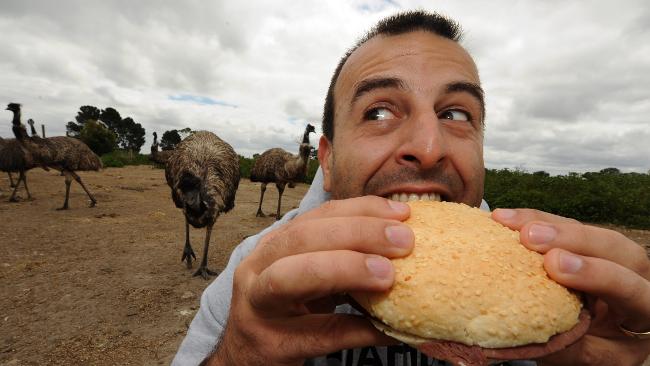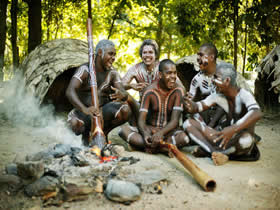
Source:The Australian Buffalo Industry Council Inc
The first buffalo arrived in the Northern Territory at Melville Island in 1825, further buffalo were introduced around that time as more outposts were set up in the Top End, a large free range population developed from buffalo that were left behind as these outposts were abandoned or escaped during relocation.
It was not until the mid 1980’s that any significant number of buffalo were sent from the NT to other Australian states.
Buffalo meat is very low in fat, less than 2% and comparatively low in cholesterol, this leanness makes buffalo meat very healthy. The fat composition in the lean meat has a higher proportion of polyunsaturated and omega 3 fatty acids than in chicken lamb or beef. Buffalo meat has been found to be very high in protein, iron and zinc content.
Buffalo Milk has
58% more calcium than cows milk!
40% more protein than cows milk!
43% less cholesterol than cows milk!
Buffalo milk is a totally natural product that can be consumed like any other milk. Time after time participants in tasting trials pick out buffalo milk in preference to cows, goats and artificially manufactured milks. They just love the taste.
Nutrition
Buffalo meat has about the same protein content as chicken, 45% more iron, 61% less saturated fat and 33% less cholesterol.
Buffalo Burger Skillet
700 grams ground buffalo
1/2 onion, chopped
garlic powder to taste
salt and pepper to taste
250gms can tomato sauce
1 cup stewed tomatoes OR diced tomatoes
300gms can whole kernel corn, drained
1 1/2 cups cooked elbow macaroni
In a large skillet over medium heat, saute the ground buffalo for 5 minutes. Add the onion and saute for 5 to 10 more minutes. Season with garlic powder, salt and pepper to taste. Add the tomato sauce, stewed OR diced tomatoes, corn and macaroni. Stir well and allow to heat through, about 5 to 7 minutes.
Buffalo Meat Loaf
1/2 cup ketchup
1/3 cup brown sugar
1/4 cup lemon juice, divided
1 teaspoon mustard powder
1 kg ground buffalo
3 slices bread, broken up into small pieces
1/4 cup chopped onion
1 egg, beaten
1 teaspoon beef bouillon granules
Preheat oven to 350 degrees F (175 degrees C).
In a small bowl, combine the ketchup, brown sugar, 1 tablespoon lemon juice and mustard powder. In a separate large bowl, combine the buffalo, bread, onion, egg, bouillon, remaining lemon juice and 1/3 of the ketchup mixture from the small bowl. Mix this well and place in a 13x23cm (5x9 inch) loaf pan. Bake at 175 degrees C (350 degrees F) for 1 hour, coat with remaining ketchup mixture and bake for 10 more minutes
Buffalo Nacho Dip
500 gms ground buffalo
1 (500gms) container salsa
1 (250gms) carton sour cream
1/2 head lettuce, finely shredded
250gms shredded Cheddar cheese
Place buffalo in a large skillet. Cook and stir over medium heat until browned. Stir in salsa, and simmer over low heat for 10 minutes. Pat cooked meat into bottom of a pie plate, cover, and refrigerate. When meat is completely chilled, spread sour cream over meat. Arrange lettuce evenly over sour cream, and top with Cheddar cheese.
Onion Mushroom Burgers
2 lb. Buffalo Burger
1 cup finely chopped onions
½ cup sliced mushrooms
Fresh ground black pepper
¼ Cup Worcestershire Sauce
Combine mushrooms, onions and burger in mixing bowl. Add Worcestershire sauce. Knead until mixed thoroughly. Make into six patties. Grind Pepper on each side of patties and rub into meat. Pan fry, broil, or grill.
STEWS
Mexican Style Buffalo Stew
1.5kgs boneless buffalo chuck roast, cut into 1-inch pieces
2 TBS. vegetable oil
1/2 tsp. salt
1 c. ready-to-serve beef broth
1 c. prepared thick and chunky salsa
2 medium zucchini, halved lengthwise, then cut crosswise into 3/4-inch thick pieces
1 can black beans, drained (400gms.)
1/2 c. whole corn kernels, frozen
2 TBS. cornstarch dissolved in 3 TBS. water
In Dutch oven or large pot, heat oil over medium-high heat until hot. Cook and stir buffalo in 2 batches; brown evenly. Pour off drippings. Return buffalo to pan. Season with salt. Stir in broth and salsa. Bring to a boil; reduce heat to low. Cover tightly and simmer gently 1-1/4 hours. Stir in zucchini, beans and corn. Bring to a boil; reduce heat to low. Cover tightly and continue simmering 15 to 20 minutes or until meat and vegetables are tender. Stir in cornstarch mixture. Bring to a boil; cook and stir 1 minute or until thickened. Serve with toppings, if desired. Makes 6 to 8 servings.
Quick Buffalo Stew
1kg ground buffalo
4 (500gms) cans mixed vegetables
4 (500gms) cans chopped tomatoes
1 large onion, chopped
ground black pepper
salt
In a large soup pot, cook ground meat over medium heat until browned. Add chopped onion, mixed vegetables, and tomatoes. Give it a stir. Reduce heat, and simmer for about 3 to 4 hours. Season to taste with salt and pepper.
STEAK RECIPES
Zesty Steak Marinade
1/3 Cup Steak Sauce
1/3 Cup Barbecue Sauce br> 1 clove minced garlicbr> 1 teaspoon onion powder
Mix steak sauce, barbecue sauce, garlic and onion powder into bowl.
Use to marinate steaks in refrigerator for at least 1 hour.
Sirloin Steak Skewers
2 - 250gm. Buffalo Sirloin Steaks, about 13mm thick
1/3 cup A.1. Steak Sauce
1/2 teaspoon coarsely ground black pepper
1/4 teaspoon ground red pepper
1/4 teaspoon ground white pepper
1. Pound steak to 6mm thickness. Spread 2 tablespoons steak sauce over meat. Sprinkle peppers evenly over steak sauce.
2. Roll up steak from short edge; cut crosswise into 8 coiled slices. On each of 4 skewers, thread 2 steak rolls through coils to secure.
3. Grill roulades over medium heat for 8 to 10 minutes or until done, turning and brushing occasionally with remaining 1/4 cup steak sauce. Serve immediately.
Peppery Filet Mignon in Red Wine
1/2 teaspoon coarsely ground black pepper
4 - 170mm. Buffalo Filet Mignons
1 tablespoon vegetable oil
1/4 cup chopped onion
1/4 cup steak Sauce
1/4 cup dry red wine
1 teaspoon dried marjoram, crushed
1. Sprinkle pepper over both sides of steaks, pressing into steak.
2. Brown steaks in hot oil in skillet over medium heat for 5 minutes on each side or until desired doneness; remove from skillet and keep warm.
3. Cook and stir onion in same skillet over medium-high heat for 3 to 4 minutes or until tender.
4. Stir in steak sauce, wine and marjoram. Heat to a boil; reduce heat. Simmer for 2 minutes or until there is about 1/3 cup sauce remaining. Serve over steaks.
Honey Mustard Sirloin
1/2 cup dijon mustard
3 tablespoons apple juice
1 teaspoon ground cinnamon
1 tablespoon honey
3 - 250gm. Buffalo top sirloin steaks
Cook on grill over medium heat.
Combine the mustard, apple juice, cinnamon and honey. Brush one side of the steak with the sauce. Grill and turn, adding more sauce.
Grill to desired doneness
Buffalo Sir fry and Spinach over pasta
500gm. Buffalo Sirloin steak
170gms. cooked thin spaghetti
1 pkg. fresh spinach, stems removed and thinly sliced (280gms.)
1 can sliced water chestnuts, drained (250gms.)
1/4 c. green onions, sliced
2 TBS. red chili peppers, chopped
Marinade:
1/4 c. hoisin sauce
2 TBS. reduced-sodium soy sauce
1 TBS. water
2 tsp. dark sesame oil
2 large cloves garlic, crushed
1/4 tsp. crushed red pepper
Stack steaks; cut lengthwise in half and then crosswise into 1-inch wide strips. Combine marinade ingredients; add buffalo, tossing to coat. Cover and marinate in refrigerator 10 minutes. Meanwhile cook pasta according to package directions; keep warm.
Remove meat from marinade. Bring marinade to a rolling boil; reserve marinade. Heat large nonstick wok or skillet over medium-high heat until hot. Add buffalo (half at a time) and stir-fry 1 to 2 minutes or until outside is no longer pink. (Do not overcook). Remove buffalo; keep warm.
In same skillet, combine pasta, spinach, water chestnuts, green onions and reserved marinade; cook until spinach is wilted and mixture is heated through, stirring occasionally. Return buffalo to skillet; mix lightly. Garnish with chili peppers. Makes 5 servings





























